Minghan Fu
NTIRE 2024 Challenge on Low Light Image Enhancement: Methods and Results
Apr 22, 2024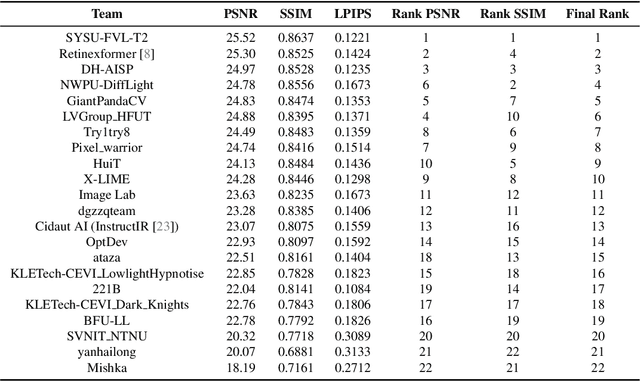

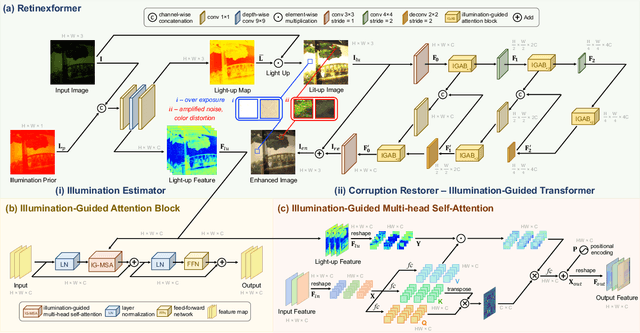

Abstract:This paper reviews the NTIRE 2024 low light image enhancement challenge, highlighting the proposed solutions and results. The aim of this challenge is to discover an effective network design or solution capable of generating brighter, clearer, and visually appealing results when dealing with a variety of conditions, including ultra-high resolution (4K and beyond), non-uniform illumination, backlighting, extreme darkness, and night scenes. A notable total of 428 participants registered for the challenge, with 22 teams ultimately making valid submissions. This paper meticulously evaluates the state-of-the-art advancements in enhancing low-light images, reflecting the significant progress and creativity in this field.
The Ninth NTIRE 2024 Efficient Super-Resolution Challenge Report
Apr 16, 2024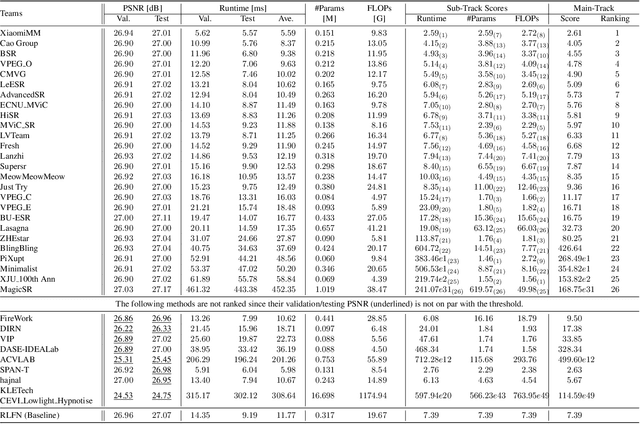
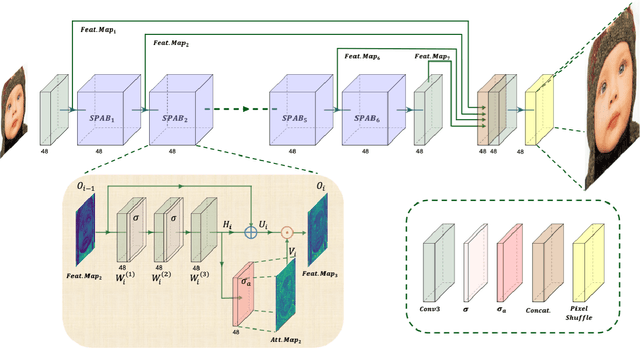


Abstract:This paper provides a comprehensive review of the NTIRE 2024 challenge, focusing on efficient single-image super-resolution (ESR) solutions and their outcomes. The task of this challenge is to super-resolve an input image with a magnification factor of x4 based on pairs of low and corresponding high-resolution images. The primary objective is to develop networks that optimize various aspects such as runtime, parameters, and FLOPs, while still maintaining a peak signal-to-noise ratio (PSNR) of approximately 26.90 dB on the DIV2K_LSDIR_valid dataset and 26.99 dB on the DIV2K_LSDIR_test dataset. In addition, this challenge has 4 tracks including the main track (overall performance), sub-track 1 (runtime), sub-track 2 (FLOPs), and sub-track 3 (parameters). In the main track, all three metrics (ie runtime, FLOPs, and parameter count) were considered. The ranking of the main track is calculated based on a weighted sum-up of the scores of all other sub-tracks. In sub-track 1, the practical runtime performance of the submissions was evaluated, and the corresponding score was used to determine the ranking. In sub-track 2, the number of FLOPs was considered. The score calculated based on the corresponding FLOPs was used to determine the ranking. In sub-track 3, the number of parameters was considered. The score calculated based on the corresponding parameters was used to determine the ranking. RLFN is set as the baseline for efficiency measurement. The challenge had 262 registered participants, and 34 teams made valid submissions. They gauge the state-of-the-art in efficient single-image super-resolution. To facilitate the reproducibility of the challenge and enable other researchers to build upon these findings, the code and the pre-trained model of validated solutions are made publicly available at https://github.com/Amazingren/NTIRE2024_ESR/.
NTIRE 2024 Challenge on Image Super-Resolution ($\times$4): Methods and Results
Apr 15, 2024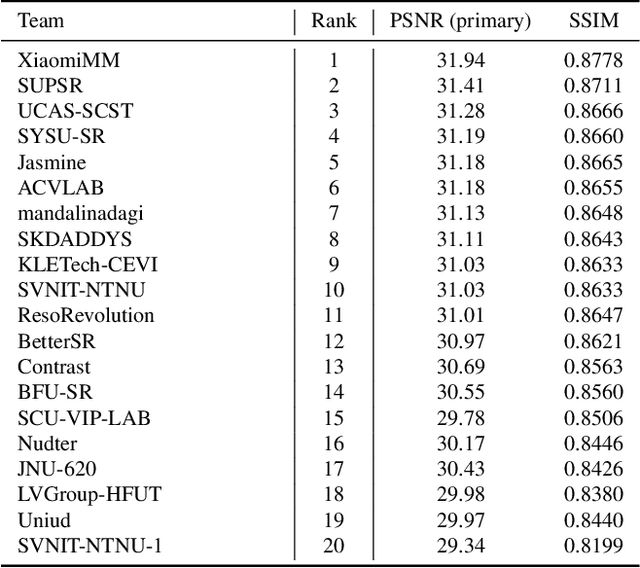
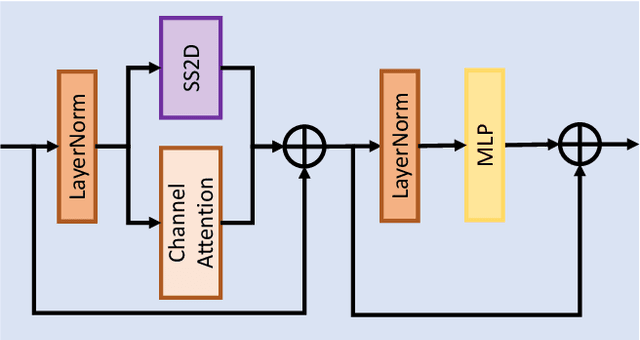
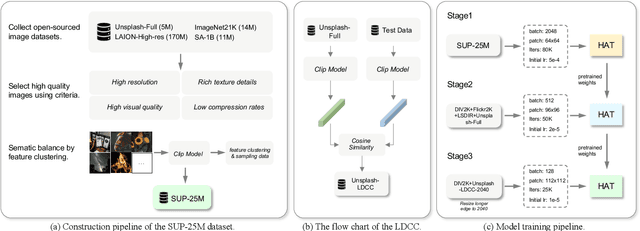
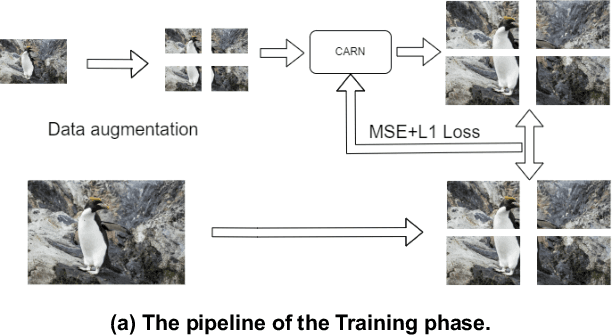
Abstract:This paper reviews the NTIRE 2024 challenge on image super-resolution ($\times$4), highlighting the solutions proposed and the outcomes obtained. The challenge involves generating corresponding high-resolution (HR) images, magnified by a factor of four, from low-resolution (LR) inputs using prior information. The LR images originate from bicubic downsampling degradation. The aim of the challenge is to obtain designs/solutions with the most advanced SR performance, with no constraints on computational resources (e.g., model size and FLOPs) or training data. The track of this challenge assesses performance with the PSNR metric on the DIV2K testing dataset. The competition attracted 199 registrants, with 20 teams submitting valid entries. This collective endeavour not only pushes the boundaries of performance in single-image SR but also offers a comprehensive overview of current trends in this field.
QLAB: Quadratic Loss Approximation-Based Optimal Learning Rate for Deep Learning
Feb 01, 2023Abstract:We propose a learning rate adaptation scheme, called QLAB, for descent optimizers. We derive QLAB by optimizing the quadratic approximation of the loss function and QLAB can be combined with any optimizer who can provide the descent update direction. The computation of an adaptive learning rate with QLAB requires only computing an extra loss function value. We theoretically prove the convergence of the descent optimizers with QLAB. We demonstrate the effectiveness of QLAB in a range of optimization problems by combining with conclusively stochastic gradient descent, stochastic gradient descent with momentum, and Adam. The performance is validated on multi-layer neural networks, CNN, VGG-Net, ResNet and ShuffleNet with two datasets, MNIST and CIFAR10.
Total-Body Low-Dose CT Image Denoising using Prior Knowledge Transfer Technique with Contrastive Regularization Mechanism
Dec 06, 2021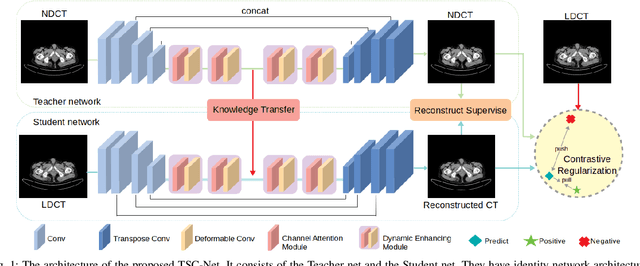
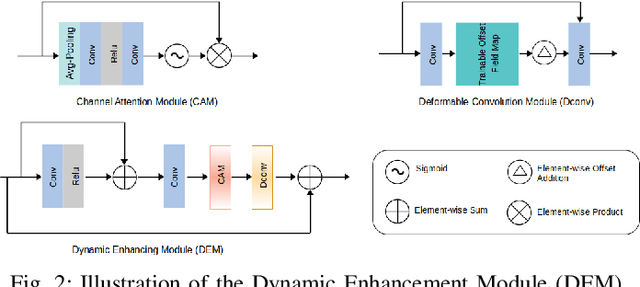

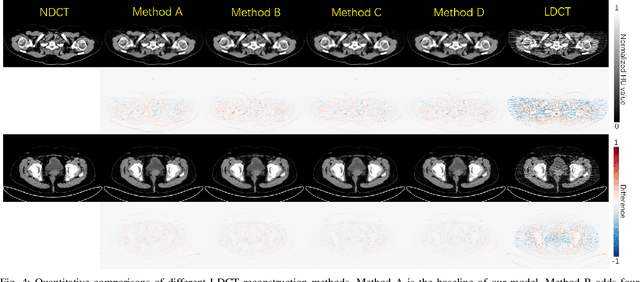
Abstract:Reducing the radiation exposure for patients in Total-body CT scans has attracted extensive attention in the medical imaging community. Given the fact that low radiation dose may result in increased noise and artifacts, which greatly affected the clinical diagnosis. To obtain high-quality Total-body Low-dose CT (LDCT) images, previous deep-learning-based research work has introduced various network architectures. However, most of these methods only adopt Normal-dose CT (NDCT) images as ground truths to guide the training of the denoising network. Such simple restriction leads the model to less effectiveness and makes the reconstructed images suffer from over-smoothing effects. In this paper, we propose a novel intra-task knowledge transfer method that leverages the distilled knowledge from NDCT images to assist the training process on LDCT images. The derived architecture is referred to as the Teacher-Student Consistency Network (TSC-Net), which consists of the teacher network and the student network with identical architecture. Through the supervision between intermediate features, the student network is encouraged to imitate the teacher network and gain abundant texture details. Moreover, to further exploit the information contained in CT scans, a contrastive regularization mechanism (CRM) built upon contrastive learning is introduced.CRM performs to pull the restored CT images closer to the NDCT samples and push far away from the LDCT samples in the latent space. In addition, based on the attention and deformable convolution mechanism, we design a Dynamic Enhancement Module (DEM) to improve the network transformation capability.
DW-GAN: A Discrete Wavelet Transform GAN for NonHomogeneous Dehazing
Apr 18, 2021
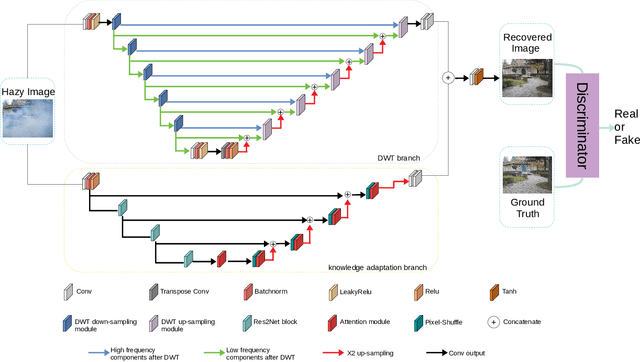


Abstract:Hazy images are often subject to color distortion, blurring, and other visible quality degradation. Some existing CNN-based methods have great performance on removing homogeneous haze, but they are not robust in non-homogeneous case. The reasons are mainly in two folds. Firstly, due to the complicated haze distribution, texture details are easy to be lost during the dehazing process. Secondly, since the training pairs are hard to be collected, training on limited data can easily lead to over-fitting problem. To tackle these two issues, we introduce a novel dehazing network using 2D discrete wavelet transform, namely DW-GAN. Specifically, we propose a two-branch network to deal with the aforementioned problems. By utilizing wavelet transform in DWT branch, our proposed method can retain more high-frequency knowledge in feature maps. In order to prevent over-fitting, ImageNet pre-trained Res2Net is adopted in the knowledge adaptation branch. Owing to the robust feature representations of ImageNet pre-training, the generalization ability of our network is improved dramatically. Finally, a patch-based discriminator is used to reduce artifacts of the restored images. Extensive experimental results demonstrate that the proposed method outperforms the state-of-the-arts quantitatively and qualitatively.
A Two-branch Neural Network for Non-homogeneous Dehazing via Ensemble Learning
Apr 18, 2021

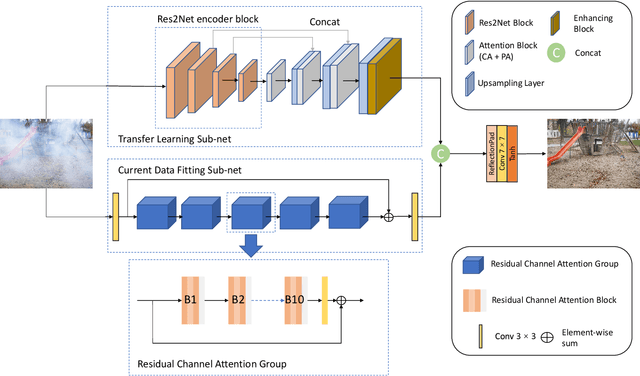
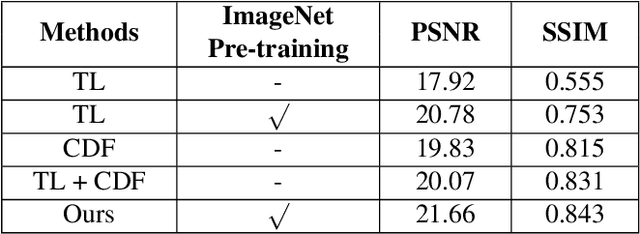
Abstract:Recently, there has been rapid and significant progress on image dehazing. Many deep learning based methods have shown their superb performance in handling homogeneous dehazing problems. However, we observe that even if a carefully designed convolutional neural network (CNN) can perform well on large-scaled dehazing benchmarks, the network usually fails on the non-homogeneous dehazing datasets introduced by NTIRE challenges. The reasons are mainly in two folds. Firstly, due to its non-homogeneous nature, the non-uniformly distributed haze is harder to be removed than the homogeneous haze. Secondly, the research challenge only provides limited data (there are only 25 training pairs in NH-Haze 2021 dataset). Thus, learning the mapping from the domain of hazy images to that of clear ones based on very limited data is extremely hard. To this end, we propose a simple but effective approach for non-homogeneous dehazing via ensemble learning. To be specific, we introduce a two-branch neural network to separately deal with the aforementioned problems and then map their distinct features by a learnable fusion tail. We show extensive experimental results to illustrate the effectiveness of our proposed method.
 Add to Chrome
Add to Chrome Add to Firefox
Add to Firefox Add to Edge
Add to Edge